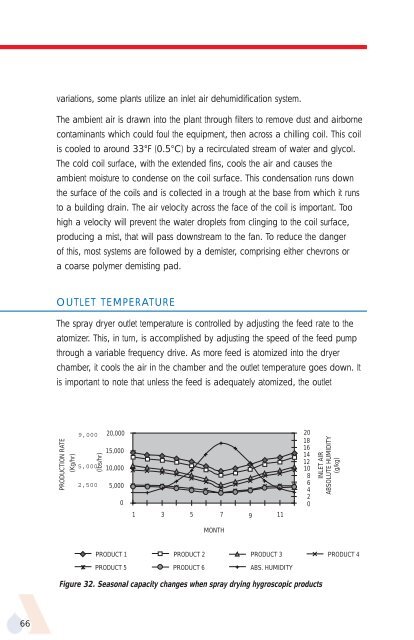APV Dryer Handbook - Umbc
APV Dryer Handbook - Umbc
APV Dryer Handbook - Umbc
You also want an ePaper? Increase the reach of your titles
YUMPU automatically turns print PDFs into web optimized ePapers that Google loves.
66<br />
variations, some plants utilize an inlet air dehumidification system.<br />
The ambient air is drawn into the plant through filters to remove dust and airborne<br />
contaminants which could foul the equipment, then across a chilling coil. This coil<br />
is cooled to around 33°F (0.5°C) by a recirculated stream of water and glycol.<br />
The cold coil surface, with the extended fins, cools the air and causes the<br />
ambient moisture to condense on the coil surface. This condensation runs down<br />
the surface of the coils and is collected in a trough at the base from which it runs<br />
to a building drain. The air velocity across the face of the coil is important. Too<br />
high a velocity will prevent the water droplets from clinging to the coil surface,<br />
producing a mist, that will pass downstream to the fan. To reduce the danger<br />
of this, most systems are followed by a demister, comprising either chevrons or<br />
a coarse polymer demisting pad.<br />
OUTLET TEMPERATURE<br />
The spray dryer outlet temperature is controlled by adjusting the feed rate to the<br />
atomizer. This, in turn, is accomplished by adjusting the speed of the feed pump<br />
through a variable frequency drive. As more feed is atomized into the dryer<br />
chamber, it cools the air in the chamber and the outlet temperature goes down. It<br />
is important to note that unless the feed is adequately atomized, the outlet<br />
PRODUCTION RATE<br />
(Kg/hr)<br />
9,000<br />
5,000<br />
2,500<br />
(lbs/hr)<br />
20,000<br />
15,000<br />
10,000<br />
5,000<br />
0<br />
1 3 5 7 9 11<br />
MONTH<br />
20<br />
18<br />
16<br />
14<br />
12<br />
10<br />
8<br />
6<br />
4<br />
2<br />
0<br />
INLET AIR<br />
ABSOLUTE HUMIDITY<br />
(g/kg)<br />
PRODUCT 1<br />
PRODUCT 2<br />
PRODUCT 3<br />
PRODUCT 4<br />
PRODUCT 5<br />
PRODUCT 6<br />
ABS. HUMIDITY<br />
Figure 32. Seasonal capacity changes when spray drying hygroscopic products











